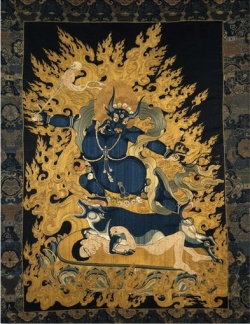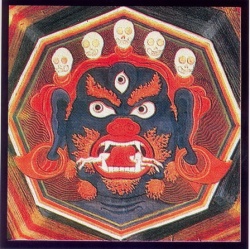Dharmapala
Click here to see other articles relating to word Dharmapala
- For Indian translator named Dharmapāla see Dharmapāla (Indian monk, translator)
In Vajrayana Buddhism, a dharmapāla (Wylie: chos skyong) is a type of wrathful deity. The name means "Dharma-defender" in Sanskrit, and the dharmapālas are also known as the Defenders of the Law (Dharma), or the Protectors of the Law, in English.
In Vajrayana iconography and Thangka depictions, dharmapālas are fearsome beings, often with many heads, many hands, or many feet. Dharmapālas often have blue, black or red skin, and a fierce expression with protruding fangs. Though dharmapālas have a terrifying appearance and countenance, they are all Bodhisattvas or Buddhas, meaning that they are embodiments of Compassion that act in a wrathful way for the benefit of Sentient beings.
In Tibet, principal Dharmapalas include:
- Mahakala (Tib. Nagpo Chenpo)
- Yama (Tib. Shinje)
- Yamantaka (Tib. Shinje Shed)
- Hayagriva (Tib. Tamdrin)
- Vaisravana (Tib. Kubera)
- Shri Devi (Tib. Palden Lhamo)
- Ekajaṭī (Tib. ral chig ma)
- Rāhula (Tib. gza)
- Vajrasādhu (Tib. Dorje Legpa)
- Tshangspa Dkarpo
- Prana Atma (Tib. Begtse)
In Tibet, most Monasteries have a dedicated dharmapāla which was originally comparable to a genius loci. The many forms of Mahakala, for example, are emanations of Avalokiteshvara. Kalarupa, Yamantaka and Shri Devi (Tib. Palden Lhamo) are considered by practitioners to be Emanations of the Buddha of Wisdom (Manjushri).
The main functions of a dharmapāla are said to be to avert the inner and outer obstacles that prevent Spiritual practitioners from attaining Spiritual realizations, as well as to foster the necessary conditions for their practice. Dharmapāla can be Buddhas, Bodhisattvas or Dharmarajas (Damchen in Tibetan). Only the dharmapālas that have realized Shunyata are seen as an object of Buddhist Refuge. As Geshe Kelsang Gyatso of the NKT says:
- A Dharma Protector (Dharmapala) is an emanation of a Buddha or a Bodhisattva whose main functions are to avert the inner and outer obstacles that prevent practitioners from gaining Spiritual realizations, and to arrange all the necessary contitions for their practice. In Tibet every Monastery had its own Dharma Protector, but the tradition did not begin in Tibet; the Mahayanists of ancient India also relied upon Dharma Protectors to eliminate hindrances and to fulfil their Spiritual wishes.
The Damchen were originally Tibetan mountain-spirits who were bound under oath to protect the Dharma by Padmasambhava and other Buddhist saints during the period of transmission of Buddhism from India to Tibet. As Geshe Kelsang Gyatso says:
- Though there are some worldly deities who are friendly towards Buddhism and who try to help practitioners, they are not real Dharma Protectors. Such worldly deities are able to increase the external Wealth of practitioners and help them to succeed in their worldly activities, but they do not have the Wisdom or the Power to protect the development of Dharma within a practitioner's Mind.
In Japan, the dharmapāla Yamantaka (Daiitoku) is classified as a Wisdom King. Some other dharmapālas, notably Mahakala (Daikoku), belong to the fourth hierarchy of deities (tenbu).
Related deities
In Tibetan Buddhism, there are two other classes of defender, the lokapālas and kṣetrapalas. Papiya, Guan Yu and Hachiman are also known as defenders.

